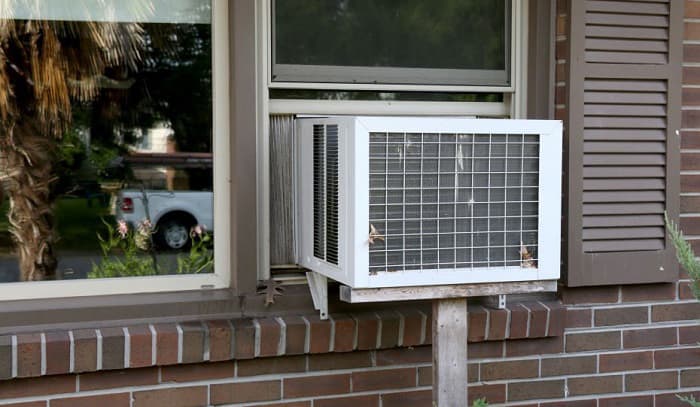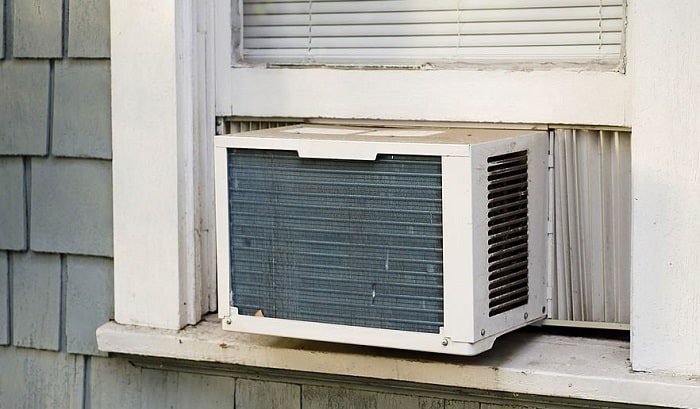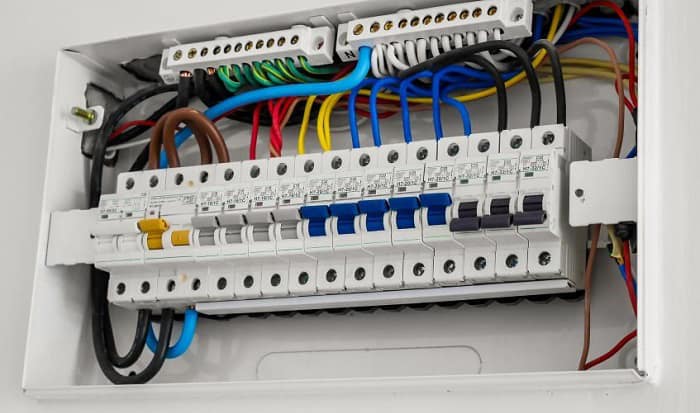If you count yourself among homeowners struggling to match ACs with their corresponding breaker sizes, this question has likely been brewing in your mind, “What size breaker for window air conditioner?”
Much like any HVAC appliance, you need to consider the voltage, BTU, current draw, and the NEC’s 125% motor load rule.
More or less, all four are factored into the two values found on the unit’s nameplate or specifications sheet: Max Fuse or Overcurrent Protection (MOP) and Minimum Circuit Ampacity (MCA).
To make sizing easy and safe, your AC breaker’s size shouldn’t go over the total amps displayed in Max Fuse or below the MCA. Read on to know why this is important and other ways you can use to size the breaker and wire.
Table of Contents
Follow the 80% Rule
Plenty of window AC units are rated for an average of around 8A. They also often don’t exceed 10,000 BTUs. This is why 15-amp breakers are relatively popular for window ACs, especially if the unit runs on 115V or 120V.
A customer once asked me how to size her 15,000 BTU AC. It had cooling amps of 7A and heating amps of 11A. Long story short, I told her to use that air conditioner on 15 amp breaker.
Did I make that recommendation because both the window AC unit amps are below 15A? Not at all, because I always consider the NEC’s 80% maximum load rule. It dictates that the operating amps should not exceed 80% of the breaker’s rated ampacity.
80% of 15A is 12A. It just so happens that both the heating and cooling amps didn’t go past that figure, so a 15A breaker would work fine with this AC.
One other client approached me, wondering why his 18,000 BTU unit tripped the breaker when he was running the heater but worked fine when cooling.
It turned out that the 20A breaker he used couldn’t handle the 22A rating of the heater, but the cooler only pulled 15A, so the unit appeared to work fine – until the heater kicked in, that is.
In the end, I just advised them to follow the figures reflected on the MCA and MOP of their respective units to avoid further issues like tripping or even overheating, which can even lead to fires. Both spare you from doing needless calculations, too.
Keep These Pointers in Mind
At best, you only have to remember these guidelines when determining air conditioning circuit breaker size:
- To avoid complications, keep the air conditioning breaker size within the ranges displayed on the MCA and Max Fuse or Max Overcurrent Protection (MOP).
- I recommend you size the breaker as high as possible (i.e. the MOP recommendation) if you have the means. I’ll explain why in the next section.
- You can choose to size the wire/conductor based on the MCA, as it should be. That said, according to section 4(G) of the NEC, air conditioners have inherent overload protection, which means the wires won’t have to handle this electrical fault.
That technically means you can still remain Code-compliant if your unit’s wire and breaker sizes don’t match each other, as long as the conductor’s size isn’t below the MCA and the breaker’s size doesn’t exceed the MOP.
Are these setups practical? Most of the time, no, because they often lead to nuisance trips.
If you’re worried, then go ahead and match them. Just know the Code makes it clear the values on the product nameplate, label, or official specs sheet override the NEC’s general OCPD guidelines.
Circuit Breaker Sizing – Why I Recommend Choosing the Max Size
For many electricians, the Max Overcurrent Protection value doesn’t only reflect the unit’s maximum ampacity but serves as a “safety net,” too.
Given their extensive experience and knowledge, they’re well aware that most AC units work less optimally over time.
Depreciation often leads to the unit pulling in more amps than it normally should. If you use the bare-minimum size circuit breaker for the air conditioner, the HVAC will likely begin to trip that breaker as it ages consistently.
This is why even if you have a unit that has an MCA of, let’s say, 28.2A, I don’t recommend settling for a 30A breaker.
Assuming it has a MOP of 45A, then it should be served by a 45-amp breaker! Trust me; it will only help you avoid nuisance trips and potential repairs down the line.
But what if the label’s no longer legible due to damage? Then I suggest you try contacting the manufacturer directly to get your unit’s specific electrical requirements.
If not, you can do the math, but I’m not guaranteeing you’ll get 100% safe figures if you go down that route.
Related: The Most Common Why Does Your Air Conditioner Keep Tripping the Circuit Breaker.
How to Calculate Amperage
- First and foremost, you need to know the unit’s exact wattage. If you happen to come across its wattage on the unit’s product listing online, then good, you can immediately start calculating the amps.
For this, you need to use the equation:
\begin{equation}
\text{Current (I)} = \frac{\text{Power (P)}}{\text{Voltage (V)}}
\end{equation}
Assuming you have a 2,000W unit with an air conditioner voltage of 115V, that gives us a total amp draw of 17A. Hold your horses, though, as we still need to factor in the NEC’s 80% rule.
\begin{equation}
\text{17A} \times \text{1.25} = \text{21.25A}
\end{equation}
Therefore, the minimum recommended size breaker for AC unit with that much draw is 25A, since we can’t choose a lower 20A breaker, and the next size available is 25A.
- But what if you can’t see the unit’s wattage anywhere? For that, you’ll need to know the unit’s EER and BTU.
These are values often shown by plenty of AC units, so you shouldn’t have a hard time looking for them.
Let’s say you’re trying to size the breaker for 3 ton AC. That’s equivalent to 36,000 BTU (since 12,000 BTU = 1 ton). Assuming the unit’s EER is 12, we will follow the formula \begin{equation}
\text{Power (Watts)} = \frac{\text{BTU}}{\text{EER}}
\end{equation} to get:
\begin{equation}
\frac{\text{36,000 BTU}}{\text{12 EER}} = \text{3000W}
\end{equation}
With the formula and factoring in the 80% rule again, assuming the unit runs on 220V, we get:
\begin{equation}
\text{Current (Amps)} = \frac{\text{Power (Watts)}}{\text{Voltage (Volts)}}
\end{equation}
\begin{equation}
\frac{\text{3000W}}{\text{220V}} = \text{13.6A};\quad \text{13.6} \times \text{1.25} = \text{17A}
\end{equation}
This means the AC needs at least a 20A breaker.
AC breaker size calculator
Of course, you don’t always have to do these manual calculations if you have a breaker size calculator available on hand. Feel free to use the one on www.allumiax.com/breaker-size-calculator.
AC breaker sizes chart
I’ve also compiled breaker size information in this amperage chart for your easy reference. It assumes all units have 12 EER.
| BTU | Voltage | Minimum Ampacity | Minimum Size |
| 5000 | 115V | 3.6A | 5A |
| 8000 | 115V | 5.8A | 10A |
| 10000 | 115V | 7.2A | 10A |
| 12000 | 115V | 8.7A | 15A |
Conclusion
I hope the points I’ve explained above have helped you know the best answer to “What size breaker for window air conditioner?” Here’s a summary of what you need to do:
- Check the unit’s nameplate for the MCA and MOP values. Keep your sizes within the range of both.
- Calculate the amps only if there’s no other source for your unit’s power requirements. Follow the formulas I’ve shared above.
- Consider sizing as large as possible
Read next:

I am Edwin Jones, in charge of designing content for Galvinpower. I aspire to use my experiences in marketing to create reliable and necessary information to help our readers. It has been fun to work with Andrew and apply his incredible knowledge to our content.




